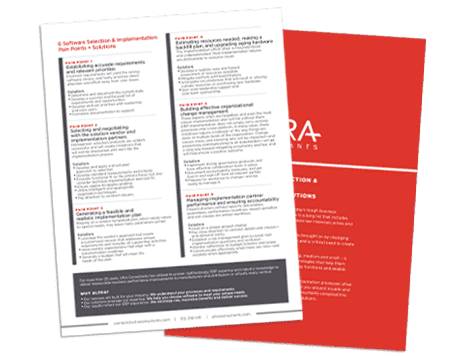We are often asked whether there is a distinction between ERP and Best of Breed enterprise systems. We hear these terms as we meet with manufacturing ERP project teams, as well as solution vendors, to classify solutions in the marketplace.
In several recent ERP selection discussions, we’ve heard the implication that Best-of-Breed and ERP are two mutually exclusive approaches.

This perspective is not quite so straightforward.
A discussion of “ERP” and “Best-of-Breed” enterprise technology solutions is much more nuanced.
Sometimes, Best-of-Breed solutions are all that is needed to drive improvements in the organization. However, more often than not, the Best-of-Breed solution needs to be integrated as part of the total solution with the ERP system.
As I’ll review in this blog post, instead of seeing one approach as separate from the other, the discussion must include the specific requirements of the company, and how to achieve a desired future state. As part of that process, consider whether a standalone ERP solution, or a combination of an ERP system and a Best-of-Breed solution, is the best fit for the company.
“Best-of-Breed” Enterprise Technology Solutions – Looking Deeper
To clear up some of the confusion when considering ERP and “Best-of-Breed,” let’s first understand the definition of both terms. A quick search on-line finds the following definitions:
- ERP: the integrated management of main business processes, often in real-time and mediated by software and technology. ERP is usually referred to as a category of business management software — typically a suite of integrated applications
- Best-of-Breed: the best system in its referenced niche or category. Although it performs specialized functions better than an integrated system, this type of system is limited by its specialty area.
These approaches are not separate from the other. Focus on the specific requirements of the company, and how to achieve a desired future state.
Characteristics of Effective ERP
In general, the key characteristics for effective use of enterprise technology include:
- All systems throughout functional areas are integrated and implemented
- A sustainable IT environment for the entire organization
- Business continuity
- All functions of the organization working from a single source of truth, even if multiple databases are used
- All functions of the organization are integrated in a way that supports business best practices
- Scalable for future growth
Considering the Best-of-Breed” Enterprise System Classification
It’s often the case that at a typical manufacturing or distribution organization, the single ERP system lacks sufficient functionality to support a critical aspect of the business. Thus, the ERP must be complemented with a specific solution that satisfies specific business requirements.
Some ERP systems come with “advanced modules” which try to alleviate the need for Best-of-Breed usage. Some come with pre-defined interfaces with Best-of-Breed solutions.
In the situation where the ERP logic is not sufficient, Best-of-Breed systems provide logic above and beyond the logic in the ERP system but they should be used as part of the total solution: i.e. in conjunction with the ERP system.
The concept goes as follows:
- In lieu of using the standard module provided by ERP, extract the data from the ERP database and send it to Best-of-Breed
- Best-of-Breed does its thing
- Best-of-Breed solution sends data back to ERP which accepts the data and updates it into the ERP database
- f done properly, ERP does not really know this detour took place. Yes, there may be a separate database being used by Best-of-Breed. Seamless integration will assure a single source of truth
Common examples of Best-of-Breed systems that we’ve seen at Ultra include:
- Customer Relationship Management (CRM) systems
- Detail Shop Floor Scheduling systems
- Warehouse Management Systems (WMS)
- Computer Aided Design (CAD) systems
- Product Lifecycle Management (PLM) systems
- Global Supply Chain Management systems
- Transportation Management Systems (TMS)
“Best of Breed systems” are not separate and independent, but are fully linked and integrated as part of the total solution.
Integration – Critical to Success
It’s part of the role of an ERP consultant to remind project teams that what is key is that any “Best of Breed systems” are not separate and independent, but are fully linked and integrated as part of the total solution.
We’ve guided ERP project teams to view the Best of Breed systems as providing logic above and beyond the logic in the ERP system but closely integrated with ERP.
We again stress that these systems are used as part of the total solution.
Consider Selection Criteria
When looking at ERP and “Best-of-Breed” enterprise systems, it’s key to move beyond the classifications.
The most successful teams understand the detailed needs of the organization when it comes to business process improvement, and then develop a specific approach to technology selection that drives value.
As an independent ERP consulting firm, we guide teams to use criteria for determining the need
- Current state analysis including process requirements
- Future state definition of how it is to be
- Software review of ERP of functional fit per the future state requirements
- Identification of any Best-of-Breed requirements
This focus on selection criteria is such an important topic and deserves additional exploration. View a webinar highlight about the importance of evaluating the current state. In addition, read an archived blog post about business process improvement and the current state.
Final Thoughts
To conclude, I would suggest that the approaches sometimes referred to as ERP and Best-of-Breed enterprise systems are not separate and independent of the total technological solution.
Instead, the two approaches can be complementary to each other, and offer specific benefits when applied in an integrated fashion.
What’s been your experience when considering Best-of-Breed enterprise systems vs. ERP? Share your feedback in the comment area below.
- Read the in-depth white paper “Setting Strategic Selection Decision Drivers” for a deeper look at this topic.
- See additional resources for ERP education to get deeper insight.
- Looking to transform your enterprise through effective use of technology? Contact Ultra for the best way to get started.

6 Software Selection & Implementation Pain Points + Solutions
Software selection and implementation processes often present challenges of their own. To steer you around trouble and help you drive success, Ultra’s experts compiled a list of pain points and solutions to be aware of as you embark on this journey.
Table of Contents
More ERP material...
AI in Food and Beverage Manufacturing
Discover how AI is revolutionizing food and beverage manufacturing, enhancing quality, reducing…
How ERP for Quality Control Eliminates Manual Documentation Chaos
This post will examine why managing quality records outside of an ERP…
Assessing Your AI Maturity
This article breaks down how businesses can measure their AI maturity to…



